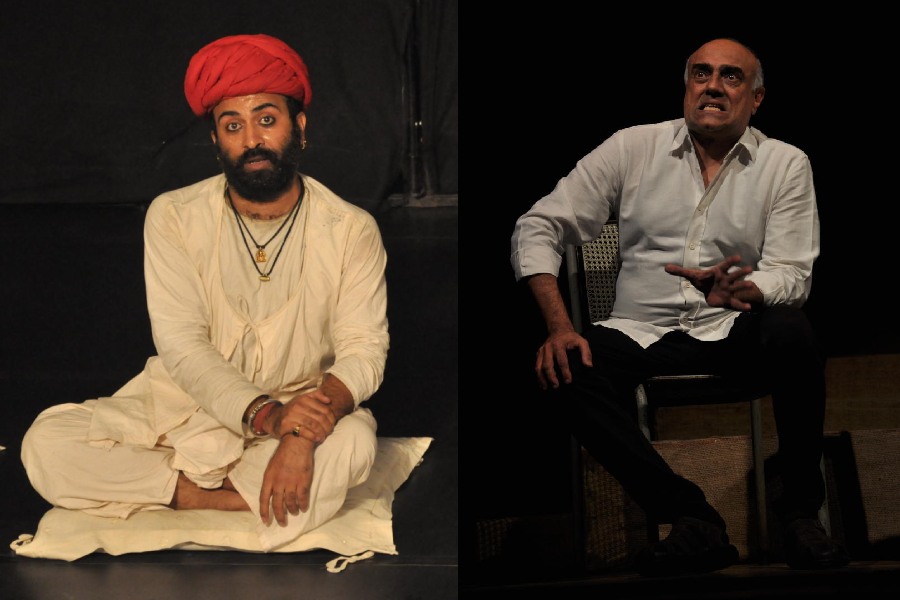‘Hmm’! ‘Haan’! ‘Um hmm’!
These are apparently innocuous linguistic registers. They, in fact, look quite incongruous on screen after the advent of Artificial Intelligence-powered subtitles. The stage — otherwise a people’s platform that has roots in intangible cultural heritage — often ignores such interjections, especially when it comes to writing down the spoken words. That explains why many of us were surprised when a production titled Hunkaro (picture, left) bagged the major awards, including those of Best Production and Best Director, at the Mahindra Excellence in Theatre Awards 2023. The Jaipur-based Ujaagar Dramatic Association came down to Calcutta to stage a few shows of Hunkaro. This reviewer caught the action at the Kolkata Centre for Creativity amphitheatre on December 23. Within minutes, the audience was transported to a land — known as Rajasthan — where storytelling is a rich tradition that is facing serious threats in the post-pandemic world.
Designed and directed by Mohit Takalkar (interestingly, a Marathi by birth), this piece, based on tales by Vijaydan Detha, Chirag Khandelwal and Arvind Charan, has a no-frills look. The stage is barren. The actors — Ajeet Singh Palawat, Ipshita Chakraborty, Puneet Mishra, Bharati Perwani, Mahesh Saini and Bhaskar Sharma — wearing the traditional Rajasthani white attire teamed with red turban, took the stage and sat in a line facing the audience. Palawat spoke first and for the first few minutes, the audience could not make any sense of what was happening. The communication seemed to fail. And, then, Palawat took time off and spoke to the audience, explaining the manifesto underlining the narration. Soon, the pieces composed in Marwari, Hindi, Awadhi and Hariyanvi began to sound meaningful. The actors — coming from various parts of North India — spoke in their respective mother tongues. And the audience — more attentive than before — began taking the hunkaros (the interjections that affirm the presence of a participatory audience) into consideration — anticipating the meanings embedded in an unknown phonetic code; waiting for cues from the next narrator. Gradually, the arena began to look more plausible. Chakraborty broke into Bangla at times, touching the hearts of the audience; Palawat explained a few words and kept the interaction going, thereby creating an immersive space. Hakam Khan Kesumbla’s musical score played the second fiddle quite competently.
This reviewer had watched Kasumal Sapno, the group’s maiden production, nine winters back, in New Delhi. The innovation that began with a localised retelling of A Midsummer Night’s Dream has found a launch pad with Hunkaro — a production that looks poised to redefine the responses of the Indian theatre audience in a multicultural, multilingual ambit.
Multilingualism also marked One on One by the Mumbai-based Rage Productions. Presented by Sanskriti Sagar at G.D. Birla Sabhaghar on January 14, this composite work, involving seven short pieces, written and directed by seven different playwrights and directors, and performed by seven actors, celebrated cosmopolitan Mumbai. ‘Seven’ may seem incidental here, for Mumbai was originally made of seven islands. Among the playlets, I’m Every Woman (written by Ayeesha Menon and directed by Faezeh Jalali) had a distinctive Franca Rame theme running through it, and Anu Menon was breathtaking in her performance. Ajitesh Gupta was effortless in TC Rasbihari (Hindi), an original piece written by Ashok Mishra and directed by Rajit Kapur. Shikha Talsania’s Dulhaniya (written by Sumeet Vyas and directed by Puja Sarup) seemed life-like. Rajit Kapur (picture, right) balanced pathos and humour in the two pieces that he acted in.










